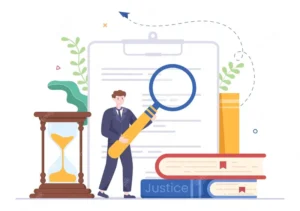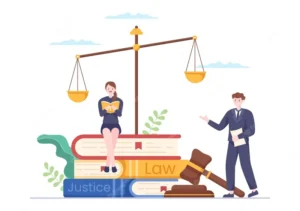How Business Law Protects Intellectual Property

In today’s rapidly evolving business landscape, innovation and creativity have become driving forces behind success. Entrepreneurs, businesses, and creators invest their time, effort, and resources into developing unique ideas, products, and content. However, with innovation comes the pressing need to safeguard these intellectual assets from theft, unauthorized use, or imitation. This is where the synergy between business and law becomes instrumental.
In this comprehensive article, we delve into the intricate realm of intellectual property and its protection through the lens of business law. Intellectual property encompasses a broad spectrum of creations, including inventions, artistic works, brand identities, and trade secrets. Business law, on the other hand, provides the legal framework and mechanisms to shield these valuable assets from infringement, ensuring that the creators and innovators reap the benefits of their ingenuity.
Throughout the following sections, we will explore the various facets of intellectual property protection. From patents that safeguard groundbreaking innovations to copyrights that preserve artistic expressions, and from trademarks that build brand identities to the clandestine world of trade secrets, we will decipher how business law fortifies these forms of intellectual property. We will also journey through the realm of IP infringement, understanding the legal actions that can be taken against violators.
Additionally, we will shed light on the strategic realm of intellectual property licensing, where businesses can leverage their IP for growth and collaboration while maintaining control. As we navigate the changing tides of technology and legislation, we’ll examine recent trends and legal updates that impact the landscape of intellectual property protection. By the end of this article, you will have a comprehensive understanding of the symbiotic relationship between business and law in the realm of intellectual property, empowering you to protect your creative and innovative endeavors effectively.
Contents
- I. Introduction
- II. Types of Intellectual Property
- III. Protection Against Intellectual Property Infringement
- IV. Licensing Intellectual Property
- V. Legislative Changes and Trends
- VI. Conclusion
- VII. F.A.Q.
- How can I protect my intellectual property rights effectively?
- What are the steps to obtain patent protection for my invention?
- Can you explain the basics of copyright law and how it applies to my work?
- What is the importance of trademark defense in branding?
- What legal actions can be taken against IP infringement?
- How do I go about safeguarding trade secrets within my business?
- Are there any recent copyright infringement cases that set legal precedents?
- What is involved in intellectual property litigation, and when should I consider it?
- What measures can businesses take to enforce their intellectual property rights?
- How are patent disputes typically resolved in court?
- What’s the process for registering a trademark, and why is it important?
- Can you explain the concept of copyright licensing and its benefits?
- What are some effective strategies for preventing IP theft?
- Are there any recent changes in intellectual property legislation that I should be aware of?
I. Introduction
A. Defining Intellectual Property and its Business Significance
Intellectual property (IP) encompasses a broad range of intangible assets, including patents, copyrights, trademarks, and trade secrets. These assets hold immense value for businesses in today’s knowledge-driven economy. They represent unique innovations, creative works, and brand identity that set companies apart in the competitive landscape.
B. The Role of Business Laws in Safeguarding Intellectual Property
Business laws provide the legal framework necessary to protect and manage intellectual property. These laws establish the rights and responsibilities of creators and inventors, outline the procedures for IP registration and enforcement, and provide remedies for IP infringement. Understanding how business laws function in this context is vital for any organization aiming to secure and leverage its intellectual property assets.
II. Types of Intellectual Property
A. Patents
1. The Patenting Process and its Business Significance
Patents grant inventors exclusive rights to their inventions for a specified period, typically 20 years. This section will explore the patent application process, from filing to approval, and highlight its significance for businesses.
2. Examples of Successful Patent Protection Cases
Through real-world examples, we’ll illustrate how business laws have been used to protect innovative technologies and products, emphasizing the role of patents in safeguarding intellectual property.
B. Copyrights
1. Understanding Copyright Fundamentals and its Corporate Relevance
Copyrights protect original creative works, such as literature, music, and software. This section will delve into the basics of copyright law and its application within the corporate sphere.
2. Leveraging Copyrights for Content Protection
We’ll explore how businesses can utilize copyright laws to shield their content from unauthorized use, reproduction, or distribution.
C. Trademarks
1. The Significance of Trademarks in Branding and Recognition
Trademarks are essential for establishing brand identity and consumer recognition. Here, we’ll discuss their pivotal role and why businesses should prioritize trademark registration.
2. The Trademark Registration Process and Compliance with Business Laws
This section will outline the process of registering and maintaining trademarks in accordance with business laws, ensuring brands retain their legal protection.
D. Safeguarding Trade Secrets
1. The Role of Trade Secrets in a Competitive Business Landscape
Trade secrets are valuable business information that provides a competitive edge. We’ll examine the importance of trade secrets and their role in maintaining market superiority.
2. Ensuring Trade Secret Protection through Business Laws and Legal Remedies
Business laws provide mechanisms to safeguard trade secrets, including contractual agreements and legal recourse in cases of misappropriation. We’ll explore these protective measures and the role of the legal system in trade secret disputes.
III. Protection Against Intellectual Property Infringement
A. Proactive Measures and Enforcement Strategies
To prevent intellectual property infringements, businesses can implement proactive strategies, such as employee training and IP audits. This section will also discuss enforcement mechanisms and the importance of cease and desist orders.
B. Intellectual Property Litigation: Exemplary Lawsuits
We’ll provide examples of notable intellectual property litigation cases, shedding light on how legal proceedings are used to resolve IP disputes and set legal precedents.
IV. Licensing Intellectual Property
A. Grasping Intellectual Property Licensing and its Business Role
Licensing allows businesses to monetize their intellectual property by granting others the right to use it. This section will define IP licensing and explore its advantages and potential risks for both licensors and licensees.
V. Legislative Changes and Trends
A. Overview of Recent Business and Intellectual Property Legislative Amendments
Business and IP laws are subject to continuous change. We’ll offer an overview of recent legislative amendments affecting intellectual property rights and business practices.
B. The Impact of Technological Advancements on Business Laws and IP Protection
The rapid pace of technological innovation necessitates adaptations in business laws. We’ll examine how emerging technologies and digital trends influence the evolution of intellectual property regulations.
VI. Conclusion
A. The Significance of Business Laws in Safeguarding Intellectual Property
In conclusion, business laws play a critical role in preserving and maximizing the value of intellectual property assets. They provide the legal foundation necessary for businesses to protect their innovations, creative works, and brand identity.
B. Final Thoughts on Leveraging Business Laws for Intellectual Property Protection
We’ll leave you with essential takeaways on how businesses can effectively utilize business laws to secure and leverage their intellectual property assets.
By understanding and leveraging business laws, companies can navigate the complex landscape of intellectual property protection, ensuring their innovations and creations remain assets of enduring value.
VII. F.A.Q.
How can I protect my intellectual property rights effectively?
To protect your intellectual property effectively, consider these strategies:
- Register Your IP: Register your patents, trademarks, and copyrights with the appropriate government agencies. Registration provides legal proof of ownership and exclusive rights.
- Use Contracts: Utilize contracts, such as nondisclosure agreements (NDAs) and licensing agreements, to clearly define the terms of use and confidentiality for your IP.
- Educate Your Team: Train your employees and partners on IP protection. Ensure they understand the value of your IP and their role in safeguarding it.
- Implement Security Measures: Implement robust cybersecurity measures to protect digital IP. Regularly update software and use encryption where applicable.
- Monitor and Enforce: Continuously monitor the market for potential infringements. Be prepared to take legal action when necessary to enforce your IP rights.
What are the steps to obtain patent protection for my invention?
Obtaining patent protection involves these key steps:
- Determine Patent Type: Decide whether your invention qualifies for a utility, design, or plant patent.
- Conduct a Patent Search: Search existing patents to ensure your invention is novel and doesn’t infringe on others’ IP.
- Prepare and File the Application: Create a detailed patent application that describes your invention thoroughly and file it with the relevant patent office.
- Examination Process: Patent offices will review your application to ensure it meets patent criteria, including novelty and non-obviousness.
- Grant of Patent: If your application is approved, you’ll be granted a patent, giving you exclusive rights to your invention for the specified period.
Can you explain the basics of copyright law and how it applies to my work?
Copyright law protects original creative works such as literature, music, and software. When you create such content, you automatically have copyright protection. This means others cannot reproduce, distribute, or display your work without your permission. Registration with the copyright office is not required but provides additional legal benefits, such as the ability to sue for statutory damages in case of infringement.
What is the importance of trademark defense in branding?
Trademarks are crucial for branding because they distinguish your products or services from competitors’. Defending your trademarks ensures that your brand’s identity remains unique. Without strong trademark protection, competitors could use similar marks, leading to brand confusion and potentially diluting the distinctiveness of your brand.
What legal actions can be taken against IP infringement?
Legal actions against IP infringement may include:
- Cease and Desist Letters: Sending a formal letter demanding the infringing party to stop using your IP.
- Filing Lawsuits: Initiating a lawsuit to seek damages or injunctions against the infringing party.
- Alternative Dispute Resolution: Opting for mediation or arbitration to resolve IP disputes outside of court.
- Customs Enforcement: Enforcing IP rights at borders to prevent counterfeit goods from entering the market.
How do I go about safeguarding trade secrets within my business?
Safeguarding trade secrets involves:
- Identification: Identify what constitutes your trade secrets.
- Access Control: Limit access to sensitive information on a need-to-know basis.
- Contracts: Use confidentiality agreements with employees and partners.
- Physical Security: Secure physical documents or prototypes.
- Cybersecurity: Implement strong digital security measures to protect electronic trade secrets.
Are there any recent copyright infringement cases that set legal precedents?
Recent cases like the “Blurred Lines” music copyright lawsuit have set precedents by addressing the boundaries of copyright infringement in creative works. It’s essential to stay updated on such cases as they can impact copyright law interpretation.
What is involved in intellectual property litigation, and when should I consider it?
Intellectual property litigation involves legal disputes over IP rights. Consider it when alternative dispute resolution methods fail, and your IP is at significant risk. Litigation typically includes complaint filing, discovery, trial, and potential appeals.
What measures can businesses take to enforce their intellectual property rights?
Enforcing IP rights requires proactive steps like monitoring the market for potential infringements, sending cease and desist letters, and initiating legal action when necessary. It’s essential to have a strategy in place and be ready to defend your rights.
How are patent disputes typically resolved in court?
Patent disputes in court follow a legal process that includes pleadings, discovery, claim construction, trial, and potential appeals. Courts may issue injunctions, damages, or royalty awards to the prevailing party.
What’s the process for registering a trademark, and why is it important?
The trademark registration process involves filing an application with the appropriate authority, such as the United States Patent and Trademark Office (USPTO). Registration grants exclusive rights to use the mark nationally, provides legal recourse in case of infringement, and enhances brand protection.
Can you explain the concept of copyright licensing and its benefits?
Copyright licensing allows copyright owners to grant others permission to use their work under specified conditions. Benefits include revenue generation, wider distribution, and partnerships that can promote creativity and innovation.
What are some effective strategies for preventing IP theft?
Effective IP theft prevention strategies include employee training, strong cybersecurity, access controls, confidentiality agreements, and monitoring for suspicious activities.
Are there any recent changes in intellectual property legislation that I should be aware of?
IP laws evolve continually. Stay updated on legislative changes, especially those related to emerging technologies and international agreements, to ensure compliance and robust IP protection.









